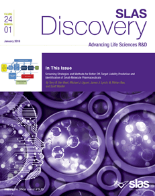
SLAS Discovery
Scope & Guideline
Highlighting Pioneering Research for a Healthier Tomorrow
Introduction
Aims and Scopes
- High-Throughput Screening (HTS):
The journal extensively covers the development and optimization of high-throughput screening methodologies for drug discovery, enabling rapid evaluation of large compound libraries against biological targets. - Cell-Based Assays and Imaging:
SLAS Discovery emphasizes the use of cell-based assays, including high-content imaging and 3D cell cultures, to better mimic in vivo conditions and enhance the relevance of screening results. - Target Identification and Validation:
Research published in the journal often focuses on novel strategies for target identification and validation, including the application of proteomics and genomics to discover new drug targets. - Automation and Robotics in Drug Discovery:
The journal highlights advancements in automation and robotics that facilitate efficient assay development and compound screening, improving reproducibility and data quality in drug discovery. - Phenotypic Screening:
SLAS Discovery also explores phenotypic screening approaches that assess biological responses to compounds in cellular models, offering insights into complex drug action mechanisms. - Emerging Technologies:
The journal is dedicated to showcasing emerging technologies such as artificial intelligence (AI) and machine learning (ML) in drug discovery, aiming to enhance data analysis and predictive capabilities.
Trending and Emerging
- COVID-19 Therapeutics:
A significant number of recent publications are dedicated to discovering and validating therapeutics for COVID-19, reflecting the urgent need for effective treatments and the journal's responsiveness to global health challenges. - 3D Cell Culture and Organoids:
There is a growing trend towards the use of 3D cell culture systems and organoids, which provide more accurate representations of human tissues, enhancing drug screening and development processes. - Artificial Intelligence and Machine Learning:
The integration of AI and machine learning techniques into drug discovery processes is on the rise, with studies focusing on data mining, predictive modeling, and automated analysis to streamline hit identification. - Targeted Protein Degradation:
Research on targeted protein degradation, particularly using PROTACs (Proteolysis Targeting Chimeras), is emerging as a significant area of interest, offering new strategies for drug discovery against challenging targets. - Synergistic Drug Combinations:
There is an increasing focus on identifying synergistic drug combinations to enhance therapeutic efficacy, particularly in cancer treatment, which reflects a shift towards personalized medicine approaches.
Declining or Waning
- Traditional Biochemical Assays:
There is a noticeable decline in publications focusing solely on traditional biochemical assays, as the field moves towards more complex and physiologically relevant models. - Single-Dimensional Drug Screening:
Research centered around single-dimensional drug screening methods is waning, with a shift towards more integrated and multi-parametric approaches that provide a broader understanding of drug effects. - Basic Pharmacology Studies:
Basic pharmacology studies that do not incorporate advanced technologies or high-throughput capabilities appear to be less frequent, as there is a growing emphasis on translational research and clinical relevance. - In Vitro Models Lacking Complexity:
The use of simplistic in vitro models is decreasing, as researchers prioritize more complex systems that better replicate human physiology, such as organoids and multi-cellular models. - Focus on Established Targets:
There is a reduction in studies targeting well-characterized pathways or proteins, as the field increasingly seeks novel targets and mechanisms of action to overcome drug resistance.
Similar Journals
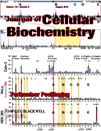
JOURNAL OF CELLULAR BIOCHEMISTRY
Pioneering Innovative Discoveries in Cellular BiologyJournal of Cellular Biochemistry is a premier academic journal dedicated to advancing the field of biochemistry and cellular biology. Published by Wiley, this influential journal has a significant impact factor that underscores its relevance and authority within the scientific community. With its ISSN 0730-2312 and E-ISSN 1097-4644, the journal has been on the frontier of research since its inception in 1982, and is expected to continue publishing cutting-edge studies through 2024. As evidenced by its ranking in the 2023 Scopus Quartiles, it holds a rank of Q2 in Biochemistry and Q3 in both Cell and Molecular Biology, placing it among the top tiers of scientific journals in these disciplines. The Journal of Cellular Biochemistry serves as a vital resource for researchers, professionals, and students alike, providing a platform for the dissemination of innovative ideas and findings that shape our understanding of cellular processes and biochemical pathways. Though it does not currently offer Open Access options, its robust peer-review process ensures that each publication meets the highest academic standards, thus solidifying its esteemed position in the landscape of biochemical research.
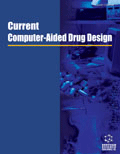
Current Computer-Aided Drug Design
Innovating Therapeutics: The Future of Drug Design Starts HereCurrent Computer-Aided Drug Design, published by BENTHAM SCIENCE PUBL LTD, is a pivotal journal dedicated to the integration of computer-aided methodologies within the drug design process. With its ISSN 1573-4099 and E-ISSN 1875-6697, this journal serves as a vital resource for researchers, professionals, and students interested in advancing the fields of pharmacology and molecular medicine. Operating under a framework that spans from 2006 to 2024, it aims to foster innovative approaches and discussions surrounding drug design strategies, computational techniques, and the therapeutic potential of novel compounds. Although it currently holds a Q4 rating in Drug Discovery and Molecular Medicine as well as a Q3 in Medicine (miscellaneous) within the 2023 category quartiles, the journal continues to enhance its visibility and relevance in the academic community. Its Scopus rankings reflect its commitment to quality research, positioning it in the context of drug discovery and molecular studies. As the field of drug design evolves, Current Computer-Aided Drug Design remains an essential platform for disseminating cutting-edge findings and facilitating collaboration among specialists aiming for significant advancements in drug development.

MOLECULAR & CELLULAR PROTEOMICS
Pioneering insights into the world of proteins.MOLECULAR & CELLULAR PROTEOMICS, published by Elsevier, stands as a premier journal in the fields of Biochemistry, Analytical Chemistry, and Molecular Biology, with a distinguished Q1 ranking reflecting its high impact and contribution to the scientific community. Established in 2002, this journal has consistently provided a platform for the latest research in protein science, merging molecular biology with advanced analytical techniques. With impressive Scopus rankings—41st in Biochemistry and 16th in Analytical Chemistry—it caters to an audience of researchers, professionals, and students eager to explore cutting-edge developments in proteomics. Although currently not designated as open access, the journal aims to foster knowledge dissemination through accessible research content. As it continues to evolve until 2024, MOLECULAR & CELLULAR PROTEOMICS is essential for anyone passionately engaged in the ever-expanding field of proteomics.

Journal of Cheminformatics
Advancing the frontiers of cheminformatics research.Journal of Cheminformatics, published by BMC, is a premier open-access journal that has been a cornerstone of cheminformatics research since its inception in 2009. With an ISSN of 1758-2946, this journal operates from the heart of the United Kingdom, providing a dynamic platform for disseminating high-quality, peer-reviewed articles that explore the integration of computer science with chemistry. The journal proudly stands in the prestigious Q1 category across multiple disciplines, including Computer Graphics, Computer-Aided Design, and Library and Information Sciences, showcasing its exceptional impact in the fields of cheminformatics and computational chemistry. Additionally, it ranks impressively in various Scopus categories, with notable placements such as #7 in Library and Information Sciences and #15 in Physical and Theoretical Chemistry, demonstrating its significance to the academic community. As a leader in open-access publishing, the Journal of Cheminformatics ensures that cutting-edge research and innovations are freely accessible to researchers, professionals, and students alike, fostering collaboration and advancement in this rapidly evolving field.
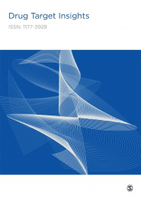
Drug Target Insights
Connecting Researchers to Transformative Drug Insights.Drug Target Insights is a prestigious peer-reviewed journal published by ABOUTSCIENCE SRL, catering to the dynamic field of pharmacology and medicinal biochemistry. With an Open Access policy since 2006, the journal aims to promote the dissemination of cutting-edge research and innovations that target drug discovery and therapeutic developments. Based in Milan, Italy, it boasts a notable impact within its research community, achieving a Q3 classification in the categories of Clinical Biochemistry and Medical Pharmacology in 2023, alongside a robust performance in the Q2 category for Pharmacology, Toxicology, and Pharmaceutics. The journal serves as a vital platform for researchers, professionals, and students seeking to advance their understanding of drug delivery systems, therapeutic targets, and pharmacodynamics. With a commitment to enhancing global access to crucial research findings, Drug Target Insights stands out as an essential resource for those engaged in the ever-evolving landscape of pharmaceutical sciences.
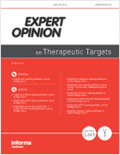
EXPERT OPINION ON THERAPEUTIC TARGETS
Illuminating the path to effective therapies through scholarly discourse.Expert Opinion on Therapeutic Targets, published by Taylor & Francis Ltd, is a highly respected journal in the fields of Clinical Biochemistry, Drug Discovery, Molecular Medicine, and Pharmacology. With a focus on cutting-edge research and innovative approaches to therapeutic development, this journal has established itself as a leading platform for scholars and practitioners, boasting a prestigious Q1 ranking across multiple categories in 2023. The journal aims to present expert perspectives on novel therapeutic strategies, promising drug candidates, and insights into the intricate mechanisms underlying various diseases. Its impressive impact factor reflects the journal's commitment to advancing scientific knowledge and influencing clinical practice. With its inception in 1997 and ongoing publication through to 2024, Expert Opinion on Therapeutic Targets continues to be an invaluable resource for those seeking to stay at the forefront of therapeutic innovations.

CELL BIOCHEMISTRY AND BIOPHYSICS
Pioneering Research in Cellular MechanismsCELL BIOCHEMISTRY AND BIOPHYSICS is a distinguished journal published by HUMANA PRESS INC, focusing on critical advancements in the fields of biochemistry, biophysics, and cell biology. Since its establishment, the journal has provided a robust platform for the dissemination of cutting-edge research, covering diverse aspects of cellular biochemistry and the physical principles that underlie biological systems. With an emphasis on interdisciplinary studies, the journal aims to facilitate knowledge exchange among researchers, professionals, and students from various scientific backgrounds. As reflected in its 2023 category rankings, it holds a respectable position in Q3 for Biochemistry and Cell Biology, and Q2 for both Biophysics and Medicine (miscellaneous), indicating its significant contribution to these fields. Although it operates under a subscription model, the journal's commitment to maintaining high publication standards ensures that only impactful studies are shared with its audience. With a range of articles spanning theoretical insights to practical applications, CELL BIOCHEMISTRY AND BIOPHYSICS is an essential resource for those aiming to stay at the forefront of biochemical and biophysical research.

MEDICINAL RESEARCH REVIEWS
Pioneering Reviews that Shape the Future of MedicineMEDICINAL RESEARCH REVIEWS, published by Wiley, is a leading journal in the fields of Drug Discovery, Molecular Medicine, and Pharmacology. With an impressive impact factor and esteemed standing in its category quartiles (Q1 in all three fields), this journal serves as a vital platform for the dissemination of cutting-edge research and reviews that drive innovation in therapeutic development and molecular health sciences. Since its inception in 1981, MEDICINAL RESEARCH REVIEWS has garnered a robust readership within the scientific community, underscored by its high rankings in Scopus – where it ranks #3 in Pharmacology and #2 in Drug Discovery, placing it within the top echelons of academic influence. Researchers, professionals, and students alike benefit from its rich content and comprehensive approaches to tackling complex medicinal challenges, making it an essential resource for those invested in advancing the frontiers of biomedical research.
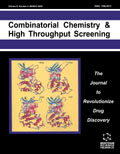
COMBINATORIAL CHEMISTRY & HIGH THROUGHPUT SCREENING
Fueling Discovery with Comprehensive Chemical MethodologiesCOMBINATORIAL CHEMISTRY & HIGH THROUGHPUT SCREENING is an esteemed journal published by Bentham Science Publishers Ltd, focusing on the rapidly evolving fields of combinatorial chemistry and high-throughput screening. With ISSN 1386-2073 and E-ISSN 1875-5402, this journal provides a critical platform for researchers, professionals, and students engaged in the development and application of novel methodologies aimed at drug discovery and organic chemistry. Since its inception in 1998, the journal has consistently contributed valuable insights, achieving a respectable 2023 Category Quartile Ranking of Q3 across relevant categories including Computer Science Applications, Drug Discovery, and Organic Chemistry. Although it does not currently provide open access options, its rigorous peer-review process and commitment to scientific excellence enhance its reputation in the academic community. Researchers can leverage this journal's findings to stay at the forefront of advancements in their fields, making it an essential resource for anyone dedicated to innovation in chemistry and related disciplines.

JOURNAL OF BIOLOGICAL CHEMISTRY
Pioneering Insights into Cellular ProcessesJOURNAL OF BIOLOGICAL CHEMISTRY, published by Elsevier, is a premier interdisciplinary journal dedicated to advancing our understanding of biochemistry, cell biology, and molecular biology. With a prestigious history dating back to 1945 and an impressive convergence of research expected to continue through 2024, this journal holds a Q1 ranking in all three of its core categories, signaling its critical influence in the respective fields, supported by a robust Scopus ranking that places it among the top echelons of internationally recognized research. Although currently not available as Open Access, the journal is essential for researchers and professionals looking to stay abreast of the latest breakthroughs and innovations in biochemical research. With a deep commitment to scientific rigor and a focus on diverse topics ranging from cellular processes to molecular mechanisms, the Journal of Biological Chemistry serves as a vital resource for the academic community, shaping the future of biological sciences.